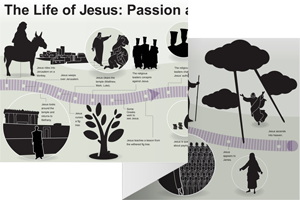17:1–26 Jesus’ prayer in this chapter is intimately linked with the themes and language of His teaching in the Gospel of John to this point. The prayer also serves as a summary of the major themes and underlying message of the Gospel leading up to the final climactic event of the passion of the Christ. Throughout chs. 14–16, Jesus foreshadowed His imminent return to the Father through death and suffering. That time is now at hand. He continues to exemplify obedience to the Father, following the inevitable path to His glorification through crucifixion. |
17:1 Glorify your Son See note on 13:31.
17:2 authority over all flesh Jesus has performed miracles and exorcisms, and He even demonstrated His power to raise someone from the dead. God also created the world through Him, which means that He is the ruler of it (1:1–3).
give eternal life Occurs through His death and resurrection (compare note on Isa 53:10). See note on John 1:4.
17:4 the work Jesus taught the disciples God’s plan for salvation, what it means to believe in Him, God’s plan for eternal life, and how to proclaim the message of salvation. Jesus is also saying that none of His disciples have been lost outside of the one whom God knew from the beginning would be lost (Judas; see note on v. 12).
17:5 glory that I had at your side Describes a position of power. Jesus is asking God the Father to raise Him to the same position He had before entering the world (compare John 1:1–4; note on Isa 53:12).
before the world existed See note on John 1:1.
17:6 I have revealed your name Throughout His ministry, Jesus has made the Father known (1:18; 5:43; 14:6–9; 17:26).
men whom you gave me Refers to those who came to Jesus to hear His message of salvation.
17:11 I am no longer in the world Jesus seems to be anticipating the state of affairs after His ascension, when the disciples are carrying on His earthly ministry. The term “world” could refer to those who oppose Jesus (see note on 16:20; compare note on 16:33). If this is the case, Jesus means that He will no longer dialogue with those who oppose Him. From this point forward, Jesus’ answers to His oppressors are minimal and straightforward; He speaks plainly (e.g., 16:25). He will go to His death in the same way as the Suffering Servant—silently (Isa 53:7).
I am coming to you Jesus will come to God’s heavenly abode through His ascension (see note on John 14:2).
your name, which you have given to me The reference here is a claim of equal status with God, who at times is called “the Name” in the ot (see Deut 12:5 and note).
your name God has given His authority to Jesus. This fits with the “I am” sayings used throughout the Gospel of John (see note on John 13:13).
may be one, just as we are Since believers are one with Jesus, and Jesus is one with God the Father, believers are one with God the Father. However, proximity to God’s holiness requires a sacrifice for believers’ sins—which takes place in Jesus’ death. Jesus has emphasized this point to His disciples throughout chs. 14–17 (compare note on 10:30).
17:12 I kept them in your name Indicates that Jesus kept His disciples secure in their faith through divine authority and power.
son of destruction Refers to Judas (see note on 13:2; note on 13:27).
17:15 evil one A general term referring to a malicious figure. In some contexts, it can refer to the devil specifically (see note on 13:2; note on 13:27).
17:17 Sanctify Refers to God’s ongoing work to set His people apart for His purposes—to make them holy as He is holy (see note on 1 Thess 4:3). The Spirit is the one who prompts and tends to this work (see note on John 14:26).
your word is truth See note on 12:48 (compare 12:50; note on 14:6).
17:24 before the foundation of the world See note on 1:1 (compare note on Gen 7:19).

|
About Faithlife Study BibleFaithlife Study Bible (FSB) is your guide to the ancient world of the Old and New Testaments, with study notes and articles that draw from a wide range of academic research. FSB helps you learn how to think about interpretation methods and issues so that you can gain a deeper understanding of the text. |
| Copyright |
Copyright 2012 Logos Bible Software. |
| Support Info | fsb |
 Loading…
Loading…


 and
and 